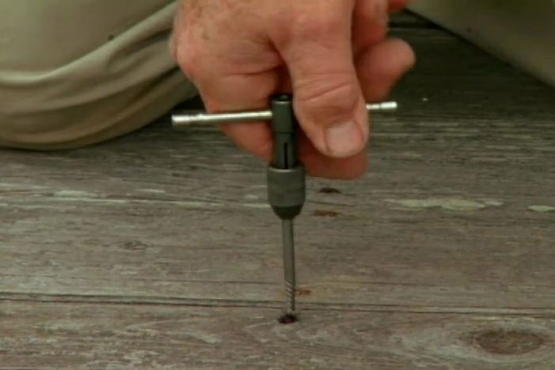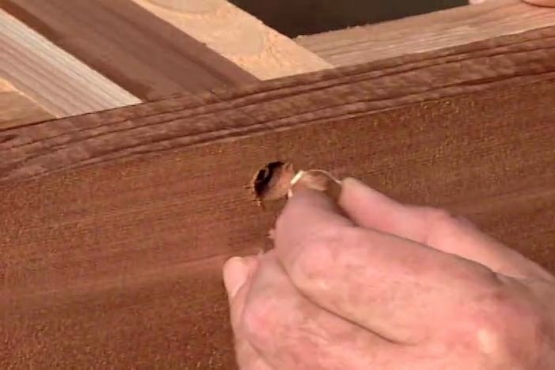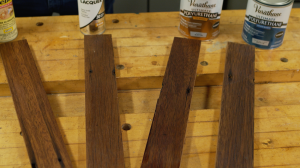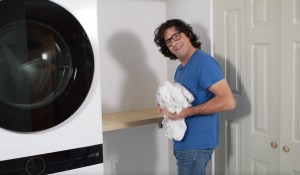Ron:
I hate when this happens. You’re putting a screw into a piece of wood, and the threads strip out. You’re turning, and spinning, and nothing’s happening. Nothing’s tightening up here. Well, there are some great solutions to this problem, and I’d like to share a few with you.
The first one is unbelievably simple. It might mean just taking that screw out, and replacing it with one that is slightly longer. Not larger necessarily, but just a little bit longer. Those few extra threads can make all the difference.
Solution number two may be as close as your kitchen cupboard. If you can’t use a longer screw for some reason, or say you don’t have one, then go to your cupboard, and get some toothpicks. For this hole right here, three ought to do it, just place them in the whole, like that, break off the excess, sometimes I take an awl just to get everything started again. Now that extra wood that we’ve put in in the form of toothpicks, makes the hole smaller, small enough so that those threads can get a grip, then it’s just a matter of running that screw back down in there. There we go.
Now door hinge screws present a different kind of problem. They often get stripped out, that’s probably because the doors are always pulling and tugging on them, but also doors are attached to a door jam like the one I’m holding in my hand right here, and you can see that these are not very thick. So sometimes a longer screw just doesn’t make any difference, and I’ve found oftentimes that toothpicks don’t work so well, either. But here is a solution that usually does work. And it involves the use of these. Plastic anchors.
You have to drill the stripped holes out. This time though, it’s important to pick a drill bit that is the same diameter as the anchor that we’re about to use. And I’m going to go all the way through the hinge holes now. Now, I’m going to take a second bit this is a counter-sink bit, it’s got a kind of a cone shape that you can see right here. And I’m going to actually counter-sink those holes that we just drilled. Just a little bit.
Now why did I do that? Because if you look at these anchors, they have a little flange, or head around here, and I want to make sure that that has a place to recess so that the top of this anchor is flush again with this hinge mortise. So now, I’m just going to set these in here, like that, push them down, and you can take a hammer and tap these down. See how nice and flush they are?
So once again, we’ll just drop this hinge in place, everything’s going to align perfectly, we haven’t changed the location of the holes, we’ve just in a sense put a liner in there with those plastic anchors. And that will give us a good grip, better than new in some cases.
Now, for my final tip: Let’s just say for example that you’ve got a board like this one, and you have a lag screw, that has just…the hole is so big that the screw actually goes through like this and spins around and there’s no bite whatsoever. And let’s suppose that you have to put this screw in that position. What do you do? Well, here’s an idea.
You’re going to have to make the hole larger in order to correct the problem, so we’re going to go up to almost a 3/8 inch bit here, and bore this out. The idea is we want to create even more space around this lag screw. All right? Now this is auto body filler, again, you can get this at an auto supply store, or most home improvement centers carry this as well. I’m going to put a little bit of this out here on my mixing board. There we go, just like that. Don’t need very much. And we’re going to add some hardener. This comes packaged with it. This is a catalyzed product, which means that by adding the hardener to this resin, things harden up very quickly. And the more resin you put in here, the more pink I make this, the shorter the work time. All right. That’s well mixed.
Now what we’re going to do is take some of this and force it into that hole. Remember that’s an oversized hole now that we’ve purposely made larger. Just keep pressing it down in there like so. Now, we’re going to take our lag screw, and I need to get some lubricant. Here we are, right here. And I’m going to spray some lubricant on here. This is going to act as a release agent. Now I’m going to place this down into that hole, and we’re going to pack some more of this around the edge.
Now what I’m doing here, is I’m casting, if you will, a thread for that lag screw. OK. We’ll give that a few minutes now to harden.
Well, it’s been about three or four minutes, so I’m just going to clean off the rest of this extra, or excess material here along the top of the bolt like this. It’ll just pop right off, you can see that it’s kind of rubbery. What I’m going to do is actually unscrew this. See this coming out?
If you take a look up inside the hole you’ll see that we’ve actually cast matching threads for the lag screw and once the resin becomes fully cured, it becomes very hard, and quite strong. so that we can just screw this right back in again.
Well I guess you can say that stripped out screws are an inevitable part of home improvement projects. But now you’ve got a whole arsenal of solutions in your toolbag. If you’d like more information on today’s projects, be sure and check our website ronhazelton.com. And join us next time for more great projects, and of course, more housecalls.








